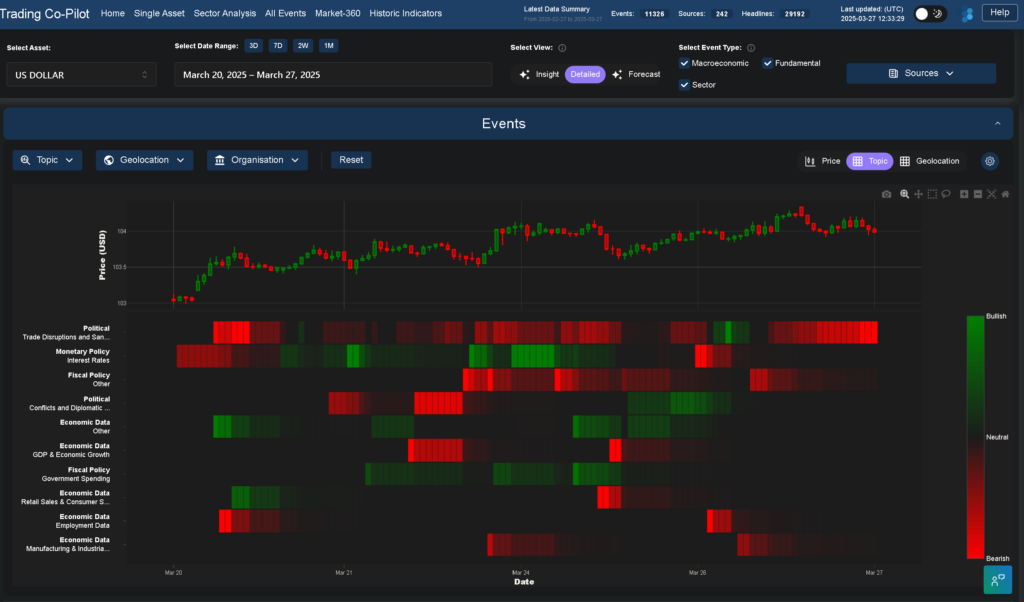*This article provides forex traders, investment analysts, and global market participants with a comprehensive examination of current USD strength, volatility drivers, and directional indicators, drawing on detailed analytics from Permutable AI’s Trading Co-Pilot to explain how tariff announcements, mixed economic data, and Federal Reserve policy are shaping dollar market sentiment.
The US dollar remains a powerful barometer for global economic health, with its movements reflecting a complex interplay of domestic policy, international relations, and market psychology. Recent weeks have witnessed substantial volatility in USD market sentiment, driven by unexpected policy announcements and mixed economic signals. Drawing from our Trading Co-Pilot’s comprehensive analysis, we’ve identified several key themes shaping current dollar dynamics which we’ll outline in this article.
Tariff announcements reshaping USD market sentiment
As March 2025 draws to a close – unsurprisingly – tariff policy has emerged as the dominant factor influencing USD market sentiment. Taking stock of the situation, our Trading Co-Pilot identified a significant market reaction on March 27th when Trump announced a 25% tariff on all foreign-made vehicles, igniting global trade tensions. The dollar’s immediate response – declining from 104.22 to 104.07 – illustrates how swiftly USD market sentiment can shift in response to policy announcements.
Viewed from another angle, these tariff announcements represent a structural shift in American trade policy, with potentially lasting implications for USD market sentiment. Given these developments, currency traders will now be recalibrating their models to account for the inflationary pressures and potential retaliatory measures that typically accompany such tariff implementations.
Bearing in mind historical precedents, tariff announcements often create initial dollar strength based on perceived American economic assertiveness. For all that, subsequent concerns about global trade disruption and retaliatory measures frequently reverse this initial sentiment. As matters stand, the USD market sentiment appears caught between these competing narratives.
Economic data: Mixed signals complicating the picture
Diving deeper into fundamental factors, economic data releases have sent conflicting signals about US economic health, further complicating USD market sentiment. Specifically speaking, our Trading Co-Pilot highlighted that on March 25th, the dollar fluctuated between 104.02 and 103.88, influenced by strong economic data, but faced pressure from declining consumer confidence, which reached a 12-year low.
Together with tariff concerns, these mixed economic indicators create a challenging environment for interpreting USD market sentiment. On the sunnier side of things, housing data showed surprising resilience, with a surprising 4.2% increase in existing home sales, indicating a rebound in the housing market. Nevertheless, this positive development was counterbalanced by rising initial jobless claims to 223,000, raising potential red flags about labour market health.
When push comes to shove, these contradictory signals create substantial uncertainty in USD market sentiment. Market participants will now find themselves weighing robust headline figures against concerning trend indicators, creating the volatility we’ve observed in recent trading sessions.

Above: USD market sentiment heatmap, taken from our Trading Co-Pilot, showing mixed sentiment across the board
Federal reserve policy: A steady hand amid turbulence
In the grand scheme of things, the Federal Reserve’s policy stance continues to provide a stabilising influence on USD market sentiment, with The Fed recently indicating it is not in a hurry to cut interest rates, leading to a stronger performance of the US dollar.
As a rule, the Fed’s cautious approach to monetary policy adjustments has historically supported dollar strength. By maintaining higher interest rates relative to other major economies, the US continues to attract capital flows seeking yield, underpinning positive USD market sentiment despite other concerns.
Having said that, the Fed’s decision to cut its US growth forecast introduces an element of caution to this narrative, indicating a potential economic slowdown yet with this, the dollar held steady at 103.80.. This resilience suggests that current USD market sentiment still prioritises interest rate differentials over growth concerns.
Geopolitical factors: Background support for safe-haven status
Behind the scenes, geopolitical tensions continue to provide background support for USD market sentiment. Even amidst concerns about American economic policy, the dollar’s safe-haven status seems to remain intact – at least, for now, where the dollar has been seemingly bolstered by ongoing geopolitical tensions.
All things considered, this persistent safe-haven appeal represents a structural support for USD market sentiment that should not be underestimated. In times of heightened global uncertainty, capital flows toward the perceived safety of US assets can override other factors driving dollar weakness.
Under the current circumstances, this dynamic creates a floor for potential dollar decline, even as tariff concerns and mixed economic data might otherwise pressure the currency. As a consequence, USD market sentiment maintains a baseline resilience despite legitimate concerns about policy direction.
Global context: Relative performance matters
In assessing USD market sentiment, we must consider the dollar’s performance in a global context. Relative to other major currencies, the dollar has demonstrated remarkable resilience. For instance, despite the EU’s decision to delay retaliatory tariffs against U.S. goods which might have strengthened the euro, the dollar maintained its position.
This relative strength highlights a critical aspect of USD market sentiment – it often reflects weakness elsewhere as much as domestic US factors. When European growth concerns, Japanese yield curve control, or Chinese property market issues dominate headlines, the dollar frequently benefits regardless of its domestic challenges.
Navigating complex USD market sentiment
To sum up, current USD market sentiment reflects a complex balancing act between policy uncertainty, mixed economic data, and the dollar’s structural role in the global financial system. The immediate outlook suggests continued range-bound trading as markets digest these competing influences.
For traders and investors navigating this environment, remaining adaptive to rapidly changing conditions will be essential. The recent tariff announcements demonstrate how quickly USD market sentiment can shift, requiring nimble positioning and risk management.
Get real-time USD market sentiment analysis
Enhance your currency trading strategy with our institutional-grade USD market sentiment analysis. Our Trading Co-Pilot platform processes thousands of of market headlines daily to identify emerging trends and sentiment shifts before they become obvious in price action. Experience how our LLM-driven insights can give you the edge in navigating volatile forex markets – email our team at enquiries@permutable.ai today to arrange your personalised demonstration or simply fill in the form below to begin your complimentary trial.
